|
|
 |
Fiche d'espèce de Copépode |
|
|
Calanoida ( Ordre ) |
|
|
|
Calanoidea ( Superfamille ) |
|
|
|
Paracalanidae ( Famille ) |
|
|
|
Calocalanus ( Genre ) |
|
|
| |
Calocalanus plumulosus (Claus, 1863) (F,M) | |
| | | | | | | Syn.: | Calanus plumulosus Claus, 1863 (p.174, Descr.F, figs.F);
Leptocalanus plumulosus : Bernard, 1958 a (p.192, figs.M); 1960 (n°36 first revision, p.4, figs.F,M); Paiva, 1963 (p.26, fig.F, Rem.); Mazza, 1966 (p.69);
Ischnocalanus plumulosus : Vervoort, 1963 b (p.115, Rem.); Neto & Paiva, 1966 (p.22, Table III); Fleminger, 1967 a (tabl.1); Corral Estrada, 1970 (p.125, figs.F, juv.M, Rem.); Deevey, 1971 (p.224); Binet & al., 1972 (p.71); Razouls, 1972 (p.94, Annexe: p.24); Corral, 1972 b (n°138, p.5, 6, figs.F, M); Roe, 1972 (p.277, tabl.1, tabl.2); Björnberg, 1973 (p.308, 387); Corral Estrada & Pereiro Muñoz, 1974 (p¿10, tab.I); Deevey & Brooks, 1977 (p.256, tab.2, Station "S"); Dessier, 1979 (p.204); Brenning, 1982 (p.4, Rem.); Vives, 1982 (p.290); Dessier, 1983 (p.89, Tableau 1, Rem., %); Scotto di Carlo & al., 1984 (1044); Kimmerer & al., 1985 (p.427); Brenning, 1985 a (p.28, Table 2); Regner, 1985 (p.24); Lozano Soldevilla & al., 1988 (p.57); Dessier, 1988 (tabl.1); Hirakawa & al., 1990 (tab.3); Suarez & al., 1990 (tab.2); Suarez, 1992 (App.1); Siokou-Frangou, 1997 (tab.1); Gilabert & Moreno, 1998 (tab.1, 2); Mauchline, 1998 (tab.58); Vukanic, 2003 (139, tab.1); Conway & al., 2003 (p.159, figs.F,M, Rem.); Isari & al., 2006 (p.241, tab.II); Zervoudaki & al., 2006 (p.149, Table I); Morales-Ramirez & Suarez-Morales, 2008 (p.518); Zakaria & al., 2016 (p.1, Table 1);
Calocalanus plumosus : Salah & Tamas, 1970 (p.333); Salah, 1971 (p.319); Renon, 1987 (tab.2);
Calocalanus plumulosus s.l. : Brinton & al., 1986 (p.228, Table 1); | | | | Ref.: | | | Giesbrecht, 1892 (p.176, 185, 770, figs.F); T. Scott, 1894 b (p.39, figs.F); Giesbrecht & Schmeil, 1898 (p.26, Rem. F); Wheeler, 1901 (p.170, fig.F, Rem.F); Thompson & Scott, 1903 (p.233, 243); A. Scott, 1909 (p.31, Rem.); Sewell, 1912 (p.353, 360); 1914 a (p.214); Pesta, 1920 (p.502); Früchtl, 1924 b (p.43); Farran, 1929 (p.208, 223); Sewell, 1929 (p.89); Wilson, 1932 a (p.41, fig.F); Rose, 1933 a (p.77, figs.F); Dakin & Colefax, 1933 (p.205); Farran, 1936 a (p.83); Dakin & Colefax, 1940 (p.93); Wilson, 1942 a (p.173, fig.F); Sewell, 1947 (p.54); Tanaka, 1956 c (p.377, figs.F,M); Chiba & al., 1957 a (p.11); Tanaka, 1960 (p.29); Heinrich, 1961 b (p.93); Grice, 1962 (p.189, figs.F, Rem.); Chen & Zhang, 1965 (p.44, figs.F); Vives, 1967 (p.551, fig.F); Chen & Zhang, 1974 (p.108, figs.M); Zheng & al., 1982 (p.24, figs.F); Bradford-Grieve, 1994 (p.61, figs.F,M, fig.99); Chihara & Murano, 1997 (p.750, Pl.71: F,M); Bradford-Grieve & al., 1999 (p.877, 910, figs.F,M); Mulyadi, 2004 (p.179, figs.F, Rem.); Avancini & al., 2006 (p.71, Pl. 40, figs.F,M, Rem.); Vives & Shmeleva, 2007 (p.955, figs.F,M, Rem.); Phukham, 2008 (p.122, figs.F) | 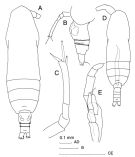 issued from : J.M. Bradford-Grieve in The Marine Fauna of New Zealand: Pelagic Calanoid Copepoda. National Institute of Water and Atmospheric Research (NIWA). New Zealand Oceanographic Institute Memoir, 102, 1994. [p.63, Fig.33]. Female: A, habitus (dorsal); B, last thoracic somite and urosome (lateral left side); C, P5. Male: D, habitus (dorsal); E, P5.
|
 issued from: Q.-c Chen & S.-z. Zhang in Studia Marina Sinica, 1965, 7. [Pl.10, 1-3]. Female (from E China Sea): 1, habitus (dorsal); 2, idem (lateral right side); 3, P5 (posterior).
|
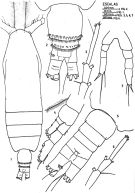 issued from : J. Corral Estrada in Tesis Doct., Univ. Madrid, A-129, Sec. Biologicas, 1970. [Lam.35]. As Ischnocalanus plumulosus. Female (from Canarias Is.): 1, habitus (dorsal); 2, urosome (dorsal); 3, distal segments of A1; 4, P1. Juvenil Male: 5, urosome (dorsal); 6, distal segments of A1. 7, P5 (abnormal or juvenile female) (after C. Razouls).
|
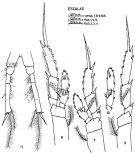 issued from : J. Corral Estrada in Tesis Doct., Univ. Madrid, A-129, Sec. Biologicas, 1970. [Lam.34, figs.7-11]. As Ischnocalanus plumulosus. Female: 7, P2; 8, P3; 9, P4 (without endopod); 10, endopod of P4; 11, P5.
|
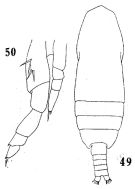 issued from : Q.-c. Chen & S.-z. Zhang in Studia Marina Sinica, 1974, 9. [Pl.5, Figs.49-50]. Male (from South China Sea): 49, habitus (dorsal); 50, P5.
|
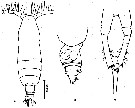 issued from : Z. Zheng, S. Li, S.J. Li & B. Chen in Marine planktonic copepods in Chinese waers. Shanghai Sc. Techn. Press, 1982 [p.25, Fig.12]. Female: a, habitus (dorsal); b, last thoracic segment and urosome (lateral, left side); c, P5. Scale bar in mm.
|
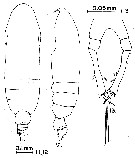 issued from : G.D. Grice in Fish. Bull. Fish and Wildl. Ser., 1962, 61. [p.186, Pl.6, Figs.11-13]. Female (from equatorial Pacific): 11-12, habitus (dorsal and lateral, respectively); 13, P5.
|
 Issued from : W. Giesbrecht in Systematik und Faunistik der Pelagischen Copepoden des Golfes von Neapel und der angrenzenden Meeres-Abschnitte. – Fauna Flora Golf. Neapel, 1892, 19 , Atlas von 54 Tafeln. [Taf.9, Fig.2]. Female: 2, A1 (ventral view).
|
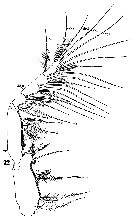 Issued from : W. Giesbrecht in Systematik und Faunistik der Pelagischen Copepoden des Golfes von Neapel und der angrenzenden Meeres-Abschnitte. – Fauna Flora Golf. Neapel, 1892, 19 , Atlas von 54 Tafeln. [Taf.9, Fig.12]. Female: 12, Mxp (posterior view).
|
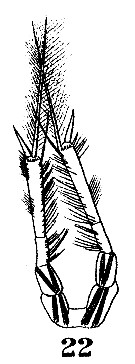 Issued from : W. Giesbrecht in Systematik und Faunistik der Pelagischen Copepoden des Golfes von Neapel und der angrenzenden Meeres-Abschnitte. – Fauna Flora Golf. Neapel, 1892, 19 , Atlas von 54 Tafeln. [Taf.9, Fig.22]. Female: 22, P5.
|
 Issued from : W. Giesbrecht in Systematik und Faunistik der Pelagischen Copepoden des Golfes von Neapel und der angrenzenden Meeres-Abschnitte. – Fauna Flora Golf. Neapel, 1892, 19 , Atlas von 54 Tafeln. [Taf.36, Figs.40, 41]. As Calocalanus plumosus. Female: 40, forehead (lateral); 41, same (dorsal).
|
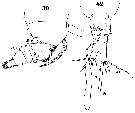 Issued from : W. Giesbrecht in Systematik und Faunistik der Pelagischen Copepoden des Golfes von Neapel und der angrenzenden Meeres-Abschnitte. – Fauna Flora Golf. Neapel, 1892, 19 , Atlas von 54 Tafeln. [Taf.36, Figs.39, 42]. As calocalanus plumosus. Female: 39, posterior part of thoracic segments and urosome (lateral); 42, urosome with spermatophore (ventral). Nota: St = distal seta 1.
|
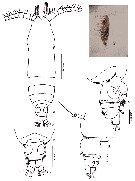 issued from : N. Phukham in Species diversity of calanoid copepods in Thai waters, Andaman Sea (Master of Science, Univ. Bangkok). 2008. [p.204, Fig.78]. Female (from W Malay Peninsula): a, habitus (dorsal); b-c, urosome (dorsal and lateral, respectively); d, last thoracic segment with P5 and urosome r(lateral). Body length after drawing: F = 0.868 mm.
|
 issued from : Mulyadi in Published by Res. Center Biol., Indonesia Inst. Sci. Bogor, 2004. [p.179, Fig.101]. Female (from 07°40'S, 109°00'E): a, habitus (dorsal); b, urosome (dorsal); c, posterior part of last thoracic segment and urosome (lateral left side); d, P5.
|
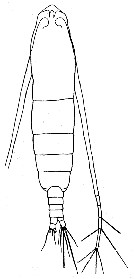 Issued from : M. Bernard in Bull. Soc. Zool. France, 1958, 83. [p.192, Fig.13]. As Leptocalanus plumulosus. Male (from Algiers Bay, Algeria): habitus. Length: 0.522 mm.
|
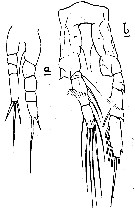 Issued from : M. Bernard in Bull. Soc. Zool. France, 1958, 83. [p.194, Fig. 14, a, b]. As Leptocalanus plumulosus. Male: a, P5; b, P4. Lengths: P5 = 155 µm; P4 = 245 µm.
| | | | | Ref. compl.: | | | Wolfenden, 1911 (p.203); Massuti Alzamora, 1942 (p.88); Oliveira, 1945 (p.191); Sewell, 1948 (p.323, 357, 391, 395, 407, 412, 414, 422, 433, 436, 439, 442, 456, 460, 463, 469, 477, 489); Yamazi, 1958 (p.148, Rem.); Fagetti, 1962 (p.12); Duran, 1963 (p.14); Heinrich, 1961 (tab.2); Gaudy, 1962 (p.93, Rem.: p.104); V.N. Greze, 1963 a (tabl.2); Shmeleva, 1963 (p.141); Gaudy, 1963 (p.21, Rem.); Björnberg, 1963 (p.30, Rem.); De Decker, 1964 (p.15, 18, 28); De Decker & Mombeck, 1964 (p.11); Grice & Hulsemann, 1965 (p.223); Shmeleva, 1965 b (p.1350, lengths-volume -weight relation); Pavlova, 1966 (p.43); Grice & Hulsemann, 1967 (p.14); De Decker, 1968 (p.45); Delalo, 1968 (p.137); Carli, 1971 (p.372, tab.1); Timonin, 1971 (p.281, trophic group); Apostolopoulou, 1972 (p.338); Carter, 1977 (1978) (p.35); Porumb, 1980 (p.168); Kovalev & Schmeleva, 1982 (p.83); Guangshan & Honglin, 1984 (p.118, tab.); De Decker, 1984 (p.315, 334: carte); Longhurst, 1985 (tab.2); Madhupratap & Haridas, 1986 (p.105, tab.1); M. Lefèvre, 1986 (p.33); Othman & al., 1990 (p.561, 563, Table 1); Yoo, 1991 (tab.1); McKinnon, 1991 (p.471); Hure & Krsinic, 1998 (p.100); Jimenez-Perez & Lara-Lara, 1988; Hattori, 1991 (tab.1, Appendix); Shih & Young, 1995 (p.71); Madhupratap & al., 1996 (p.866); Padmavati & Goswami, 1996 a (p.85, fig.3, Table 4, vertical distribution); Kotani & al., 1996 (tab.2); Padmavati & al., 1998 (p.349); Suarez-Morales & Gasca, 1998 a (p108); Noda & al., 1998 (p.55, Table 3, occurrence); Smith S. & al., 1998 (p.2369, Table 6, moonsoon effects); Lavaniegos & Gonzalez-Navarro, 1999 (p.239, Appx.1); Razouls & al., 2000 (p.343, Appendix); Fernandez-Alamo & al., 2000 (p.1139, Appendix); Madhupratap & al., 2001 (p. 1345, vertical distribution vs. O2, figs.4, 5: clusters); Lo & al., 2001 (1139, tab.I); Shimode & Shirayama, 2004 (tab.2); Hsiao & al., 2004 (p.326, tab.1); Hsieh & al., 2004 (p.397, tab.1, p.399, tab.2); Daly Yahia & al., 2004 (p.366, fig.4); Lan & al., 2004 (p.332, tab.1); Lo & al.*, 2004 (p.218, fig.6); Lo & al., 2004 (p.89, tab.1); Prusova & Smith, 2005 (p.75); Hwang & al., 2006 (p.943, tabl. I); Hwang & al., 2007 (p.23); Dur & al., 2007 (p.197, Table IV); Khelifi-Touhami & al., 2007 (p.327, Table 1); Jitlang & al., 2008 (p.65, Table 1); Ayon & al., 2008 (p.238, Table 4: Peruvian samples); Fernandes, 2008 (p.465, Tabl.2); Lan Y.C. & al., 2008 (p.61, Table 1, % vs stations); Tseng L.-C. & al., 2008 (p.153, Table 2, fig.5, occurrence vs geographic distribution, indicator species); Tseng & al., 2008 (p.402, Table 2); McKinnon & al., 2008 (p.844: Tab.1); C.-Y. Lee & al., 2009 (p.151, Tab.2); Cornils & al., 2010 (p.2076, Table 3); Schnack-Schiel & al., 2010 (p.2064, Table 2: E Atlantic subtropical/tropical); Fazeli & al., 2010 (p.153, Table 1); Mazzocchi & Di Capua, 2010 (p.426); W.-B. Chang & al., 2010 (p.735, Table 2, abundance); Hsiao S.H. & al., 2011 (p.475, Appendix I); Tseng L.-C. & al., 2011 (p.239, Table 3, abundance %); Tseng L.-C. & al., 2011 (p.47, Table 2, occurrences vs mesh sizes); Maiphae & Sa-ardrit, 2011 (p.641, Table 2, 3, Rem.); Pillai H.U.K. & al., 2011 (p.239, Table 3, vertical distribution); Isari & al., 2011 (p.51, Table 2, abundance vs distribution); Selifonova, 2011 a (p.77, Table 1, alien species in Black Sea); Kâ & Hwang, 2011 (p.155, Table 3: occurrence %); Shiganova & al., 2012 (p.61, Table 4); Uysal & Shmeleva, 2012 (p.909, Table I); Tseng & al., 2012 (p.621, Table 3: abundance); Jang M.-C & al., 2012 (p.37, abundance and seasonal distribution); Belmonte & al., 2013 (p.222, Table 2, abundance vs. stations); Cornils & Blanco-Bercial, 2013 (p.861, Table 1, molecular analysis, figs.3, 4, 5); in CalCOFI regional list (MDO, Nov. 2013; M. Ohman, pers. comm.); Tseng & al., 2013 (p.507, seasonal abundance); Lidvanov & al., 2013 (p.290, Table 2, % composition); Hwang & al., 2014 (p.43, Appendix A: seasonal abundance); Mazzocchi & al., 2014 (p.64, Table 4, 5, abundance) ; Benedetti & al., 2016 (p.159, Table I, fig.1, functional characters); El Arraj & al., 2017 (p.272, table 2, spatial distribution); Benedetti & al., 2018 (p.1, Fig.2: ecological functional group); Belmonte, 2018 (p.273, Table I: Italian zones); Chaouadi & Hafferssas, 2018 (p.913, Table II: occurrence); Palomares-Garcia & al., 2018 (p.178, Table 1: occurrence) | | | | NZ: | 19 | | |
|
Carte de distribution de Calocalanus plumulosus par zones géographiques
|
| | | | | | | | | | | | | | |  issued from : A.A. Shmeleva in Bull. Inst. Oceanogr., Monaco, 1965, 65 (n°1351). [Table 6: 11 ]. Calocalanus plumulosus (from South Adriatic). issued from : A.A. Shmeleva in Bull. Inst. Oceanogr., Monaco, 1965, 65 (n°1351). [Table 6: 11 ]. Calocalanus plumulosus (from South Adriatic).
Dimensions, volume and Weight wet. Means for 50-60 specimens. Volume and weight calculated by geometrical method. Assumed that the specific gravity of the Copepod body is equal to 1, then the volume will correspond to the weight. |
| | | | Loc: | | | Cosmopolite (tropical & sub-tropical): sub-Antarct. (Indian), South Africa (E & W), Atlant., Angola (Baia Farta), G. of Guinea, Ivorian shelf, Caribbean Sea, G. of Mexico, Florida, off Bermuda: Station "S" (32°10'N, 64°30'W), Canary Is., Morocco-Mauritania, Moroccan copast, Medit. (Alboran Sea, Sidi Fredj coast, N Tunisia, Banyuls, Marseille, Ligurian Sea, Napoli, Messina, Gulf of Taranto, Adriatic Sea, Ionian Sea, Aegean Sea, Thracian Sea, Lebanon Basin, W Egyptian coast, Alexandria, Black Sea), Red Sea, Gulf of Oman, G. of Aden, Arabian Sea, Maldive Is., Indian, Goa - Gujarat, Sri Lanka, Madras, Bay of Bengal, Nicobar Is., Barren Island, S Burma, W Malay Peninsula (Andaman Sea), G. of Thailand, Indonesia-Malaysia, Cilacap Bay (S Java); SW Celebes, China Seas (Yellow Sea, East China Sea, South China Sea), Kuroshio Current region, Taiwan (S, E, SW, W, N, Mienhua Canyon, NW, NE), S Korea, Korea Strait, Japan (Onagawa, Toyama Bay), off Japan (Kuchinoerabu Is., SE, NE), California, G. of California, La Paz, G. de Tehuantepec, W Costa Rica, off Guatemala W, Clipperton Is., Pacif. ( W equatorial), Australia (Shark Bay, New South Wales, Great Barrier, G. of Carpentaria), New Caledonia, New Zealand, Moorea Is., Peru, Chile
Data from Cornils & Blanco-Bercial (2013): 05°11'S; 143°16'W. | | | | N: | 183 | | | | Lg.: | | | (11) F: 1,083-1,039; (14) F: 1,1; (34) F: 1,05; (35) F: 1,3-1,17; (45) F: 1,25-0,9; (47) F: 1,2-0,93; (55) F: 1,18-1; M: 0,9-0,88; (66) F: 0,92; (73) F: 1,16-1,14; (101) F: 0,87; (188) F: 1,2-0,93; (196) F: 1,2-0,99; M: 0,83; (199) F: 1,22-1,06; (202) F: 0,9-1,2; (237) F: 0,90; (290) F: 1,2-1; (338) M: 0,8-0,65; (449) F: 1,2-0,93; (920) F: 1,04; (991) F: 0,87-1,25; M: 0,83-0,9; (1023) F: 0,93-1,11; (1112) F: 1,25-1,344; (1122) F: 0,95; (1131) M: 0,522; (1132) F: 0,93-1,2; M: 0,83-0,9; {F: 0,87-1,34; M: 0,522-0,90} | | | | Rem.: | épipélagique.
Sampling depth (sub-Antarct.) : 0-150 m.
Voir aussi les remarques en anglais | | | Dernière mise à jour : 25/10/2022 | |
|
|
 Toute utilisation de ce site pour une publication sera mentionnée avec la référence suivante : Toute utilisation de ce site pour une publication sera mentionnée avec la référence suivante :
Razouls C., Desreumaux N., Kouwenberg J. et de Bovée F., 2005-2025. - Biodiversité des Copépodes planctoniques marins (morphologie, répartition géographique et données biologiques). Sorbonne Université, CNRS. Disponible sur http://copepodes.obs-banyuls.fr [Accédé le 04 décembre 2025] © copyright 2005-2025 Sorbonne Université, CNRS
|
|
 |
 |



















